A Study of a Severe Spring Dust Event in 2021 over East Asia with WRF-Chem and Multiple Platforms of Observations
Abstract
:1. Introduction
2. Model, Observational Datasets and Methodology
2.1. Model Descriptions and Configuration
2.2. Datasets
2.2.1. Particle Mass Concentrations
2.2.2. The AOD from Himawari-8
2.2.3. CALIPSO Aerosol Vertical Extinction Coefficient
3. Results
3.1. Temporal and Spatial Distributions of Simulated Dust Emissions
3.2. Spatial Distribution of Simulated Dust Mass Concentrations
3.3. Spatial Distribution of Simulated AODs and Extinction Coefficient
4. Discussion
5. Conclusions
Author Contributions
Funding
Data Availability Statement
Acknowledgments
Conflicts of Interest
References
- Li, H.; Wang, C. Impact of Dust Radiation Effect on Simulations of Temperature and Wind—A Case Study in Taklimakan Desert. Atmos. Res. 2022, 273, 106163. [Google Scholar] [CrossRef]
- Liu, Y.; Hua, S.; Jia, R.; Huang, J. Effect of Aerosols on the Ice Cloud Properties Over the Tibetan Plateau. J. Geophys. Res. Atmos. 2019, 124, 9594–9608. [Google Scholar] [CrossRef]
- DeMott, P.J.; Prenni, A.J.; Liu, X.; Kreidenweis, S.M.; Petters, M.D.; Twohy, C.H.; Richardson, M.S.; Eidhammer, T.; Rogers, D.C. Predicting Global Atmospheric Ice Nuclei Distributions and Their Impacts on Climate. Proc. Natl. Acad. Sci. USA 2010, 107, 11217–11222. [Google Scholar] [CrossRef] [PubMed] [Green Version]
- Lohmann, U.; Feichter, J. Global Indirect Aerosol Effects: A Review. Atmos. Chem. Phys. 2005, 5, 715–737. [Google Scholar] [CrossRef] [Green Version]
- Zheng, Y.; Zhao, T.; Che, H.; Liu, Y.; Han, Y.; Liu, C.; Xiong, J.; Liu, J.; Zhou, Y. A 20-Year Simulated Climatology of Global Dust Aerosol Deposition. Sci. Total Environ. 2016, 557–558, 861–868. [Google Scholar] [CrossRef]
- Xia, W.; Wang, Y.; Chen, S.; Huang, J.; Wang, B.; Zhang, G.J.; Zhang, Y.; Liu, X.; Ma, J.; Gong, P.; et al. Double Trouble of Air Pollution by Anthropogenic Dust. Environ. Sci. Technol. 2022, 56, 761–769. [Google Scholar] [CrossRef]
- Karagulian, F.; Temimi, M.; Ghebreyesus, D.; Weston, M.; Kondapalli, N.K.; Valappil, V.K.; Aldababesh, A.; Lyapustin, A.; Chaouch, N.; Al Hammadi, F.; et al. Analysis of a Severe Dust Storm and Its Impact on Air Quality Conditions Using WRF-Chem Modeling, Satellite Imagery, and Ground Observations. Air Qual. Atmos. Health 2019, 12, 453–470. [Google Scholar] [CrossRef] [Green Version]
- Kumar, R.; Barth, M.C.; Madronich, S.; Naja, M.; Carmichael, G.R.; Pfister, G.G.; Knote, C.; Brasseur, G.P.; Ojha, N.; Sarangi, T. Effects of Dust Aerosols on Tropospheric Chemistry during a Typical Pre-Monsoon Season Dust Storm in Northern India. Atmos. Chem. Phys. 2014, 14, 6813–6834. [Google Scholar] [CrossRef] [Green Version]
- Goudie, A.S. Desert Dust and Human Health Disorders. Environ. Int. 2014, 63, 101–113. [Google Scholar] [CrossRef]
- Kang, J.-Y.; Yoon, S.-C.; Shao, Y.; Kim, S.-W. Comparison of Vertical Dust Flux by Implementing Three Dust Emission Schemes in WRF/Chem. J. Geophys. Res. Atmos. 2011, 116. [Google Scholar] [CrossRef] [Green Version]
- Ginoux, P.; Prospero, J.; Torres, O.; Chin, M. Long-Term Simulation of Global Dust Distribution with the GOCART Model: Correlation with North Atlantic Oscillation. Environ. Model. Softw. 2004, 19, 113–128. [Google Scholar] [CrossRef]
- Zhang, X.Y.; Arimoto, R.; An, Z.S. Dust Emission from Chinese Desert Sources Linked to Variations in Atmospheric Circulation. J. Geophys. Res. Atmos. 1997, 102, 28041–28047. [Google Scholar] [CrossRef]
- Qian, Z.; Cai, Y.; Liu, J.; Li, D.; Song, M. Some advances in dust storm research over China-Mongolia areas. Chin. J. Geophys. 2006, 49, 83–92. [Google Scholar] [CrossRef]
- Yin, Z.; Wan, Y.; Zhang, Y.; Wang, H. Why Super Sandstorm 2021 in North China? Natl. Sci. Rev. 2022, 9, nwab165. [Google Scholar] [CrossRef]
- Guan, Q.; Sun, X.; Yang, J.; Pan, B.; Zhao, S.; Wang, L. Dust Storms in Northern China: Long-Term Spatiotemporal Characteristics and Climate Controls. J. Clim. 2017, 30, 6683–6700. [Google Scholar] [CrossRef]
- Zhang, X.-X.; Sharratt, B.; Chen, X.; Wang, Z.-F.; Liu, L.-Y.; Guo, Y.-H.; Li, J.; Chen, H.-S.; Yang, W.-Y. Dust Deposition and Ambient PM10 Concentration in Northwest China: Spatial and Temporal Variability. Atmos. Chem. Phys. 2017, 17, 1699–1711. [Google Scholar] [CrossRef] [Green Version]
- Shin, Y.-R.; Sohn, E.-H.; Park, K.-H.; Ryu, G.-H.; Lee, S.; Lee, S.-Y.; Park, N.-Y. Improved Dust Detection over East Asia Using Geostationary Satellite Data. Asia-Pac. J. Atmos. Sci. 2021, 57, 787–798. [Google Scholar] [CrossRef]
- Jin, J.; Segers, A.; Heemink, A.; Yoshida, M.; Han, W.; Lin, H.-X. Dust Emission Inversion Using Himawari-8 AODs Over East Asia: An Extreme Dust Event in May 2017. J. Adv. Modeling Earth Syst. 2019, 11, 446–467. [Google Scholar] [CrossRef]
- Wu, C.; Lin, Z.; Liu, X.; Li, Y.; Lu, Z.; Wu, M. Can Climate Models Reproduce the Decadal Change of Dust Aerosol in East Asia? Geophys. Res. Lett. 2018, 45, 9953–9962. [Google Scholar] [CrossRef]
- Wu, C.; Lin, Z. Uncertainty in Dust Budget over East Asia Simulated by WRF/Chem with Six Different Dust Emission Schemes. Atmos. Ocean. Sci. Lett. 2013, 6, 428–433. [Google Scholar] [CrossRef]
- Chen, S.; Huang, J.; Qian, Y.; Zhao, C.; Kang, L.; Yang, B.; Wang, Y.; Liu, Y.; Yuan, T.; Wang, T.; et al. An Overview of Mineral Dust Modeling over East Asia. J. Meteorol. Res. 2017, 31, 633–653. [Google Scholar] [CrossRef]
- Darmenova, K.; Sokolik, I.N.; Shao, Y.; Marticorena, B.; Bergametti, G. Development of a Physically Based Dust Emission Module within the Weather Research and Forecasting (WRF) Model: Assessment of Dust Emission Parameterizations and Input Parameters for Source Regions in Central and East Asia. J. Geophys. Res. Atmos. 2009, 114. [Google Scholar] [CrossRef]
- Su, L.; Fung, J.C.H. Sensitivities of WRF-Chem to Dust Emission Schemes and Land Surface Properties in Simulating Dust Cycles during Springtime over East Asia. J. Geophys. Res. Atmos. 2015, 120, 11,215–11,230. [Google Scholar] [CrossRef] [Green Version]
- Yu, X.; Wang, T.; Liu, C.; Pu, L. Numerical Studies on a Severe Dust Storm in East Asia Using WRF-Chem. ACS 2017, 7, 92–116. [Google Scholar] [CrossRef] [Green Version]
- Zeng, Y.; Wang, M.; Zhao, C.; Chen, S.; Liu, Z.; Huang, X.; Gao, Y. WRF-Chem v3.9 Simulations of the East Asian Dust Storm in May 2017: Modeling Sensitivities to Dust Emission and Dry Deposition Schemes. Geosci. Model Dev. 2020, 13, 2125–2147. [Google Scholar] [CrossRef]
- Chen, S.; Yuan, T.; Zhang, X.; Zhang, G.; Feng, T.; Zhao, D.; Zang, Z.; Liao, S.; Ma, X.; Jiang, N.; et al. Dust Modeling over East Asia during the Summer of 2010 Using the WRF-Chem Model. J. Quant. Spectrosc. Radiat. Transf. 2018, 213, 1–12. [Google Scholar] [CrossRef]
- Rizza, U.; Barnaba, F.; Miglietta, M.M.; Mangia, C.; Di Liberto, L.; Dionisi, D.; Costabile, F.; Grasso, F.; Gobbi, G.P. WRF-Chem Model Simulations of a Dust Outbreak over the Central Mediterranean and Comparison with Multi-Sensor Desert Dust Observations. Atmos. Chem. Phys. 2017, 17, 93–115. [Google Scholar] [CrossRef] [Green Version]
- Zhao, J.; Ma, X.; Wu, S.; Sha, T. Dust Emission and Transport in Northwest China: WRF-Chem Simulation and Comparisons with Multi-Sensor Observations. Atmos. Res. 2020, 241, 104978. [Google Scholar] [CrossRef]
- Han, T.; Pan, X.; Wang, X. Evaluating and Improving the Sand Storm Numerical Simulation Performance in Northwestern China Using WRF-Chem and Remote Sensing Soil Moisture Data. Atmos. Res. 2021, 251, 105411. [Google Scholar] [CrossRef]
- Ginoux, P.; Chin, M.; Tegen, I.; Prospero, J.M.; Holben, B.; Dubovik, O.; Lin, S.-J. Sources and Distributions of Dust Aerosols Simulated with the GOCART Model. J. Geophys. Res. Atmos. 2001, 106, 20255–20273. [Google Scholar] [CrossRef]
- LeGrand, S.L.; Polashenski, C.; Letcher, T.W.; Creighton, G.A.; Peckham, S.E.; Cetola, J.D. The AFWA Dust Emission Scheme for the GOCART Aerosol Model in WRF-Chem v3.8.1. Geosci. Model Dev. 2019, 12, 131–166. [Google Scholar] [CrossRef] [Green Version]
- Shao, Y. A Model for Mineral Dust Emission. J. Geophys. Res. Atmos. 2001, 106, 20239–20254. [Google Scholar] [CrossRef]
- Shao, Y. Simplification of a Dust Emission Scheme and Comparison with Data. J. Geophys. Res. Atmos. 2004, 109. [Google Scholar] [CrossRef] [Green Version]
- Shao, Y.; Ishizuka, M.; Mikami, M.; Leys, J.F. Parameterization of Size-Resolved Dust Emission and Validation with Measurements. J. Geophys. Res. Atmos. 2011, 116. [Google Scholar] [CrossRef]
- Wang, Q.; Zhuang, G.; Huang, K.; Liu, T.; Lin, Y.; Deng, C.; Fu, Q.; Fu, J.S.; Chen, J.; Zhang, W.; et al. Evolution of Particulate Sulfate and Nitrate along the Asian Dust Pathway: Secondary Transformation and Primary Pollutants via Long-Range Transport. Atmos. Res. 2016, 169, 86–95. [Google Scholar] [CrossRef]
- Jin, J.; Pang, M.; Segers, A.; Han, W.; Fang, L.; Li, B.; Feng, H.; Lin, H.X.; Liao, H. Inverse Modeling of the 2021 Spring Super Dust Storms in East Asia. Atmos. Chem. Phys. 2022, 22, 6393–6410. [Google Scholar] [CrossRef]
- Hersbach, H.; Bell, B.; Berrisford, P.; Hirahara, S.; Horányi, A.; Muñoz-Sabater, J.; Nicolas, J.; Peubey, C.; Radu, R.; Schepers, D.; et al. The ERA5 global reanalysis. Q. J. R. Meteorol. Soc. 2020, 146, 1999–2049. [Google Scholar] [CrossRef]
- Aijun, D.; Stauffer, D.; Gaudet, B.; Dudhia, J.; Hacker, J.; Bruyere, C.; Wu, W.; Vandenberghe, F.; Liu, Y.; Bourgeois, A. 1.9 Update on WRF-ARW End-to-End Multi-Scale FDDA System; WRF Users’ Workshop: Boulder, CO, USA, 2009. [Google Scholar]
- Ngan, F.; Stein, A.F. A long-term WRF meteorological archive for dispersion simulations: Application to controlled tracer experiments. J. Appl. Meteorol. Climatol. 2017. [CrossRef]
- Li, M.; Liu, H.; Geng, G.; Hong, C.; Liu, F.; Song, Y.; Tong, D.; Zheng, B.; Cui, H.; Man, H.; et al. Anthropogenic emission inventories in China: A review. Natl. Sci. Rev. 2017, 4, 834–866. [Google Scholar] [CrossRef]
- Zheng, B.; Tong, D.; Li, M.; Liu, F.; Hong, C.; Geng, G.; Li, H.; Li, X.; Peng, L.; Qi, J.; et al. Trends in China’s anthropogenic emissions since 2010 as the consequence of clean air actions. Atmos. Chem. Phys. 2018, 18, 14095–14111. [Google Scholar] [CrossRef] [Green Version]
- Li, M.; Zhang, Q.; Kurokawa, J.-I.; Woo, J.-H.; He, K.; Lu, Z.; Ohara, T.; Song, Y.; Streets, D.G.; Carmichael, G.R.; et al. MIX: A mosaic Asian anthropogenic emission inventory under the international collaboration framework of the MICS-Asia and HTAP. Atmos. Chem. Phys. 2017, 17, 935–963. [Google Scholar] [CrossRef] [Green Version]
- Thompson, G.; Rasmussen, R.M.; Manning, K. Explicit Forecasts of Winter Precipitation Using an Improved Bulk Microphysics Scheme. Part I: Description and Sensitivity Analysis. Mon. Weather Rev. 2004, 132, 519–542. [Google Scholar] [CrossRef] [Green Version]
- Iacono, M.J.; Delamere, J.S.; Mlawer, E.J.; Shephard, M.W.; Clough, S.A.; Collins, W.D. Radiative Forcing by Long-Lived Greenhouse Gases: Calculations with the AER Radiative Transfer Models. J. Geophys. Res. Atmos. 2008, 113. [Google Scholar] [CrossRef]
- Chou, M.-D.; Suarez, M.J. A Solar Radiation Parameterization (CLIRAD-SW) Developed at Goddard Climate and Radiation Branch for Atmospheric Studies. NASA Tech. Memo. 1999, 15, 48. [Google Scholar]
- Matsui, T.K.; Matsubayashi, M.; Sakaguchi, Y.M.; Hayashi, R.K.; Zheng, C.; Sugie, K.; Hasegawa, M.; Nakagawa, T.; Mori, E. Six-Month Cultured Cerebral Organoids from Human ES Cells Contain Matured Neural Cells. Neurosci. Lett. 2018, 670, 75–82. [Google Scholar] [CrossRef]
- Nakanishi, M.; Niino, H. An Improved Mellor–Yamada Level-3 Model: Its Numerical Stability and Application to a Regional Prediction of Advection Fog. Bound.-Layer Meteorol. 2006, 119, 397–407. [Google Scholar] [CrossRef]
- Chen, F.; Mitchell, K.; Schaake, J.; Xue, Y.; Pan, H.-L.; Koren, V.; Duan, Q.Y.; Ek, M.; Betts, A. Modeling of Land Surface Evaporation by Four Schemes and Comparison with FIFE Observations. J. Geophys. Res. Atmos. 1996, 101, 7251–7268. [Google Scholar] [CrossRef] [Green Version]
- Stockwell, W.R.; Middleton, P.; Chang, J.S.; Tang, X. The Second Generation Regional Acid Deposition Model Chemical Mechanism for Regional Air Quality Modeling. J. Geophys. Res. 1990, 95, 16343–16367. [Google Scholar] [CrossRef]
- Geng, G.; Zhang, Q.; Tong, D.; Li, M.; Zheng, Y.; Wang, S.; He, K. Chemical Composition of Ambient PM2.5 over China and Relationship to Precursor Emissions during 2005–2012. Atmos. Chem. Phys. 2017, 17, 9187–9203. [Google Scholar] [CrossRef] [Green Version]
- Boylan, J.W.; Russell, A.G. Pm and light extinction model performance metrics, goals, and criteria for three-dimensional air quality models. Atmos. Environ. 2006, 40, 4946–4959. [Google Scholar] [CrossRef]
- Bessho, K.; Date, K.; Hayashi, M.; Ikeda, A.; Imai, T.; Inoue, H.; Kumagai, Y.; Miyakawa, T.; Murata, H.; Ohno, T.; et al. An Introduction to Himawari-8/9—Japan’s New-Generation Geostationary Meteorological Satellites. J. Meteorol. Soc. Jpn. 2016, 94, 151–183. [Google Scholar] [CrossRef] [Green Version]
- Gao, L.; Chen, L.; Li, C.; Li, J.; Che, H.; Zhang, Y. Evaluation and Possible Uncertainty Source Analysis of JAXA Himawari-8 Aerosol Optical Depth Product over China. Atmos. Res. 2021, 248, 105248. [Google Scholar] [CrossRef]
- Sekiyama, T.T.; Yumimoto, K.; Tanaka, T.Y.; Nagao, T.; Kikuchi, M.; Murakami, H. Data Assimilation of Himawari-8 Aerosol Observations: Asian Dust Forecast in June 2015. Sola 2016, 12, 86–90. [Google Scholar] [CrossRef] [Green Version]
- Xu, W.; Wang, W.; Chen, B. Comparison of hourly aerosol retrievals from JAXA Himawari/AHI in version 3.0 and a simple customized method. Sci. Rep. 2020, 10, 20884. [Google Scholar] [CrossRef] [PubMed]
- Winker, D.M.; Pelon, J.; Mccormick, M.P. The CALIPSO mission: Spaceborne lidar for observation of aerosols and clouds. SPIE Asia-Pac. Remote Sens. 2003, 4893, 1211–1229. [Google Scholar] [CrossRef] [Green Version]
- Winker, D.M.; Vaughan, M.A.; Omar, A.; Hu, Y.; Powell, K.A.; Liu, Z.; Hunt, W.H.; Young, S.A. Overview of the CALIPSO Mission and CALIOP Data Processing Algorithms. J. Atmos. Ocean. Technol. 2009, 26, 2310–2323. [Google Scholar] [CrossRef]
- Omar, A. A Decade of CALIPSO Observations of Asian and Saharan Dust Properties near Source and Transport Regions. E3S Web Conf. 2019, 99, 02008. [Google Scholar] [CrossRef]
- Han, Y.; Wang, T.; Tang, J.; Wang, C.; Jian, B.; Huang, Z.; Huang, J. New Insights into the Asian Dust Cycle Derived from CALIPSO Lidar Measurements. Remote Sens. Environ. 2022, 272, 112906. [Google Scholar] [CrossRef]
- Yang, F.; Chongyi, E. Correlation analysis between sand-dust events and meteorological factors in Shapotou, Northern China. Environ. Earth Sci. 2010, 59, 1359–1365. [Google Scholar] [CrossRef]
- Dai, T.; Cheng, Y.; Zhang, P.; Shi, G.; Sekiguchi, M.; Suzuki, K.; Goto, D.; Nakajima, T. Impacts of meteorological nudging on the global dust cycle simulated by nicam coupled with an aerosol model. Atmos. Environ. 2018, 190, 99–115. [Google Scholar] [CrossRef]
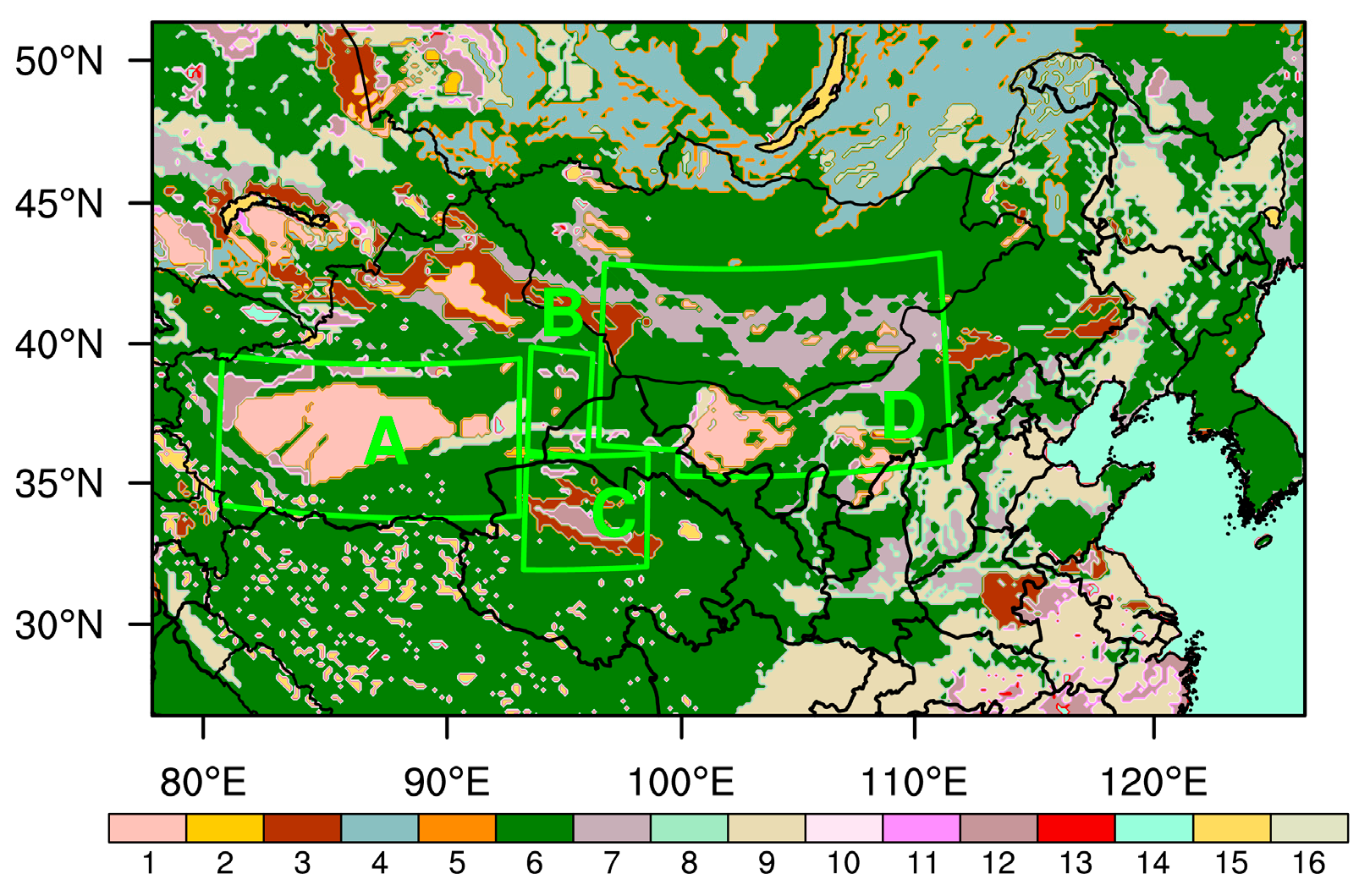
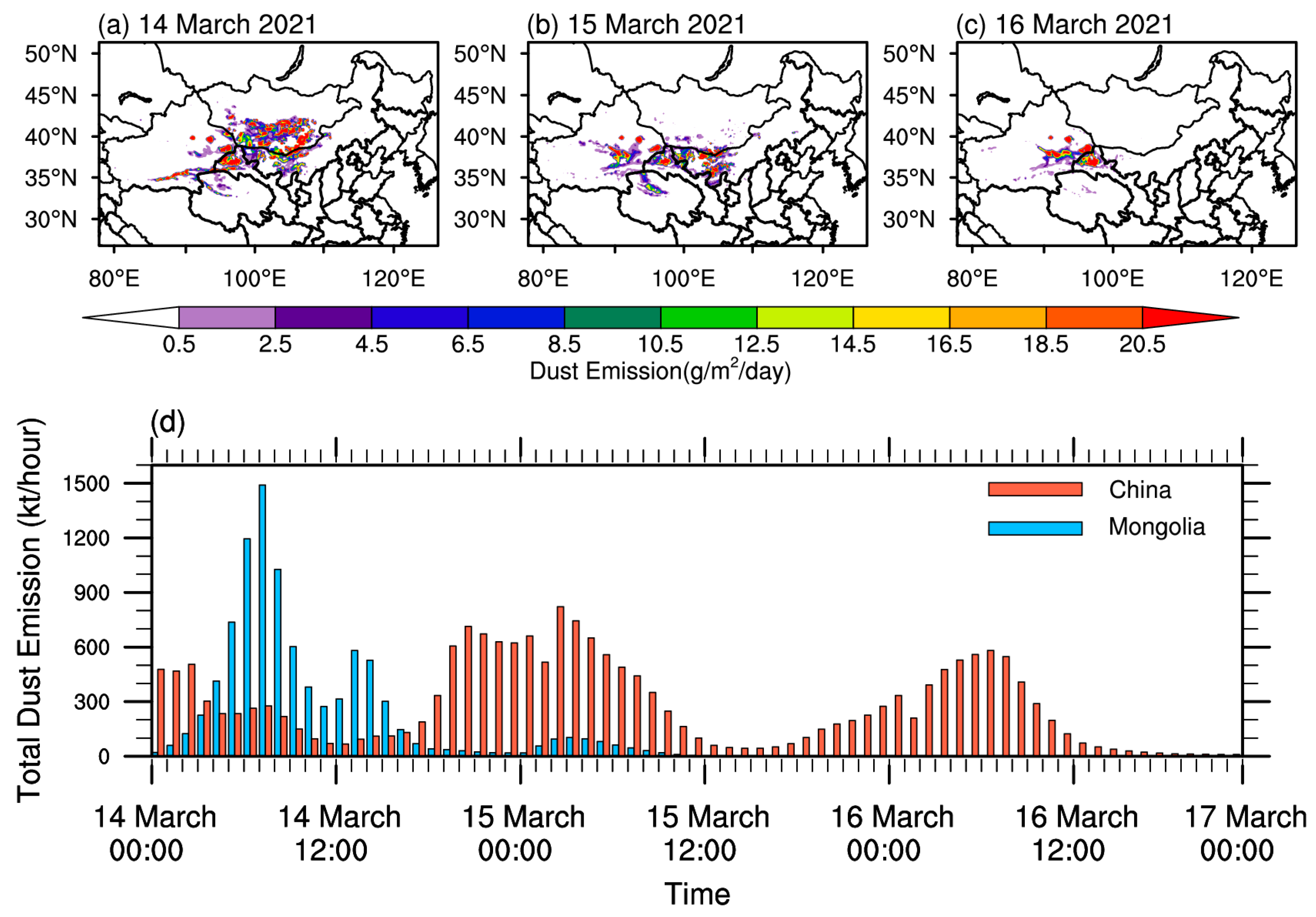



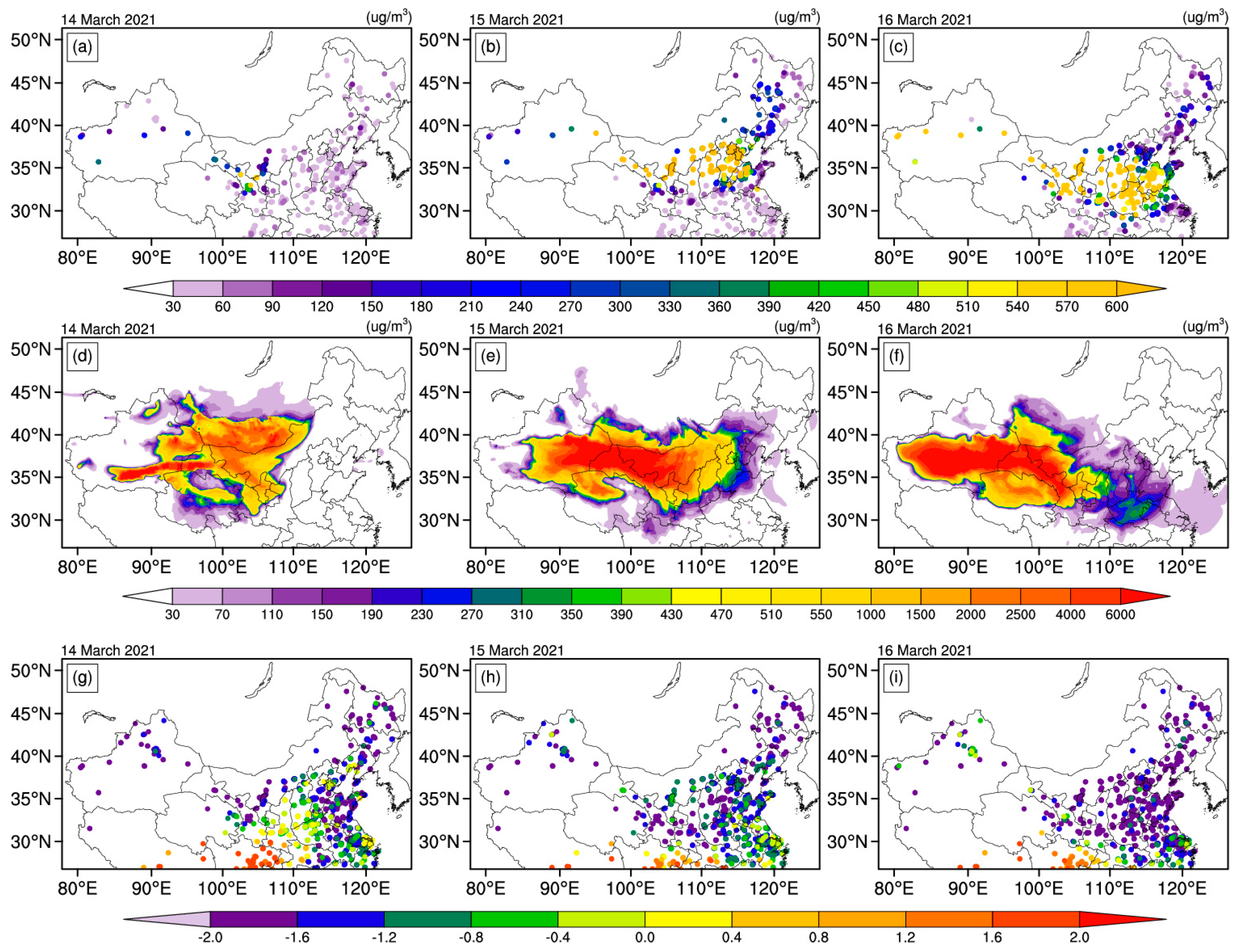

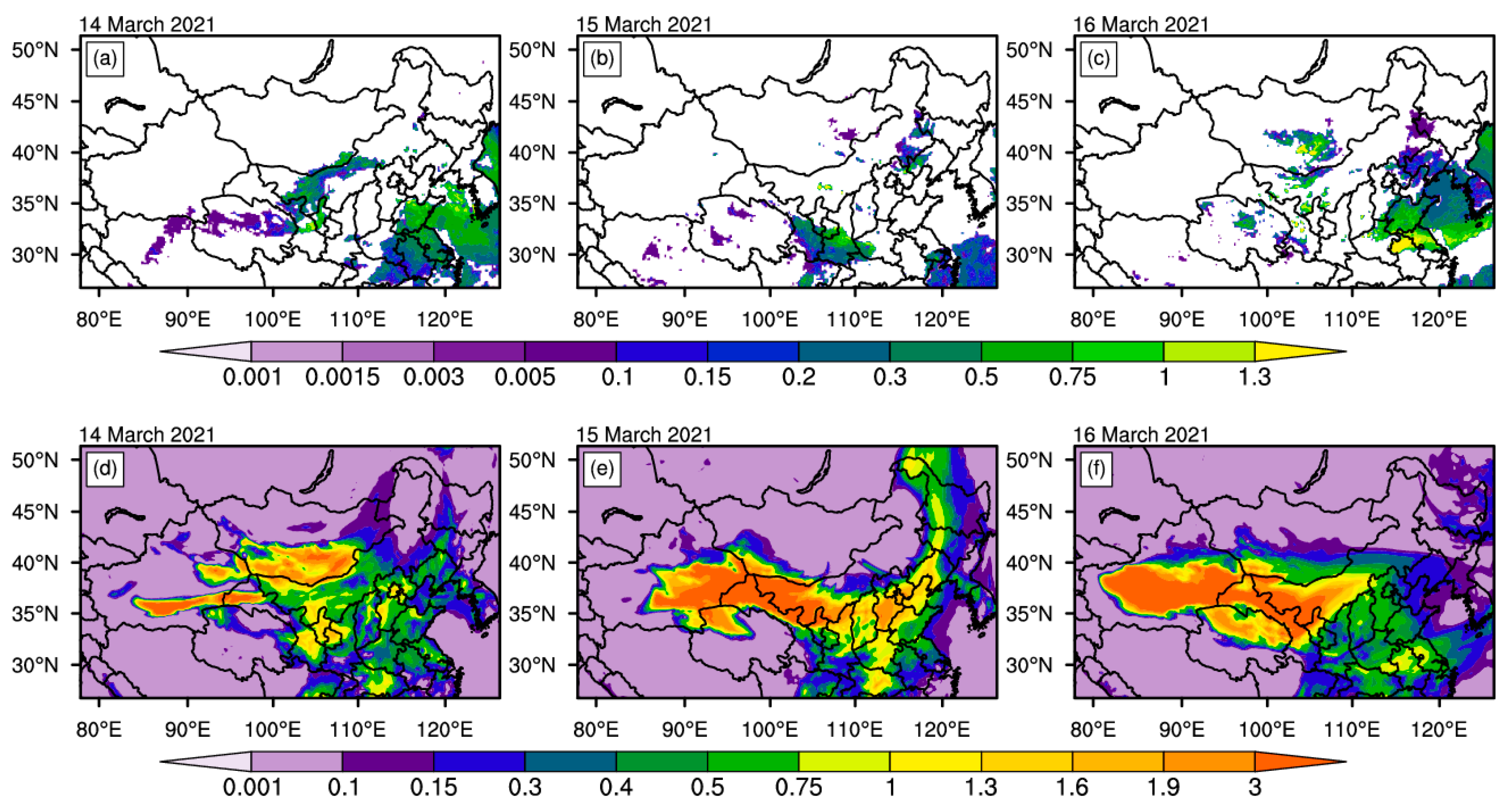
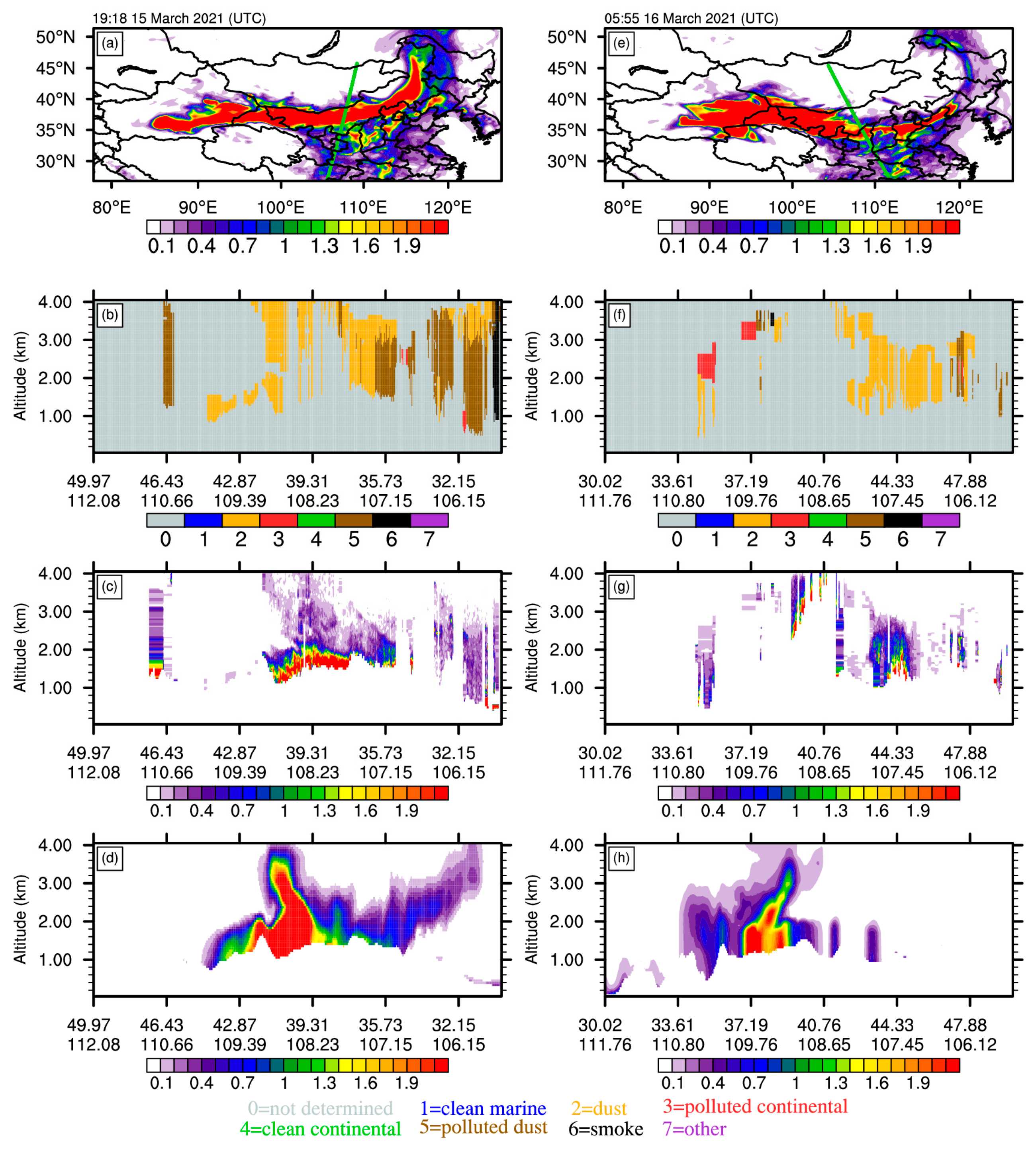
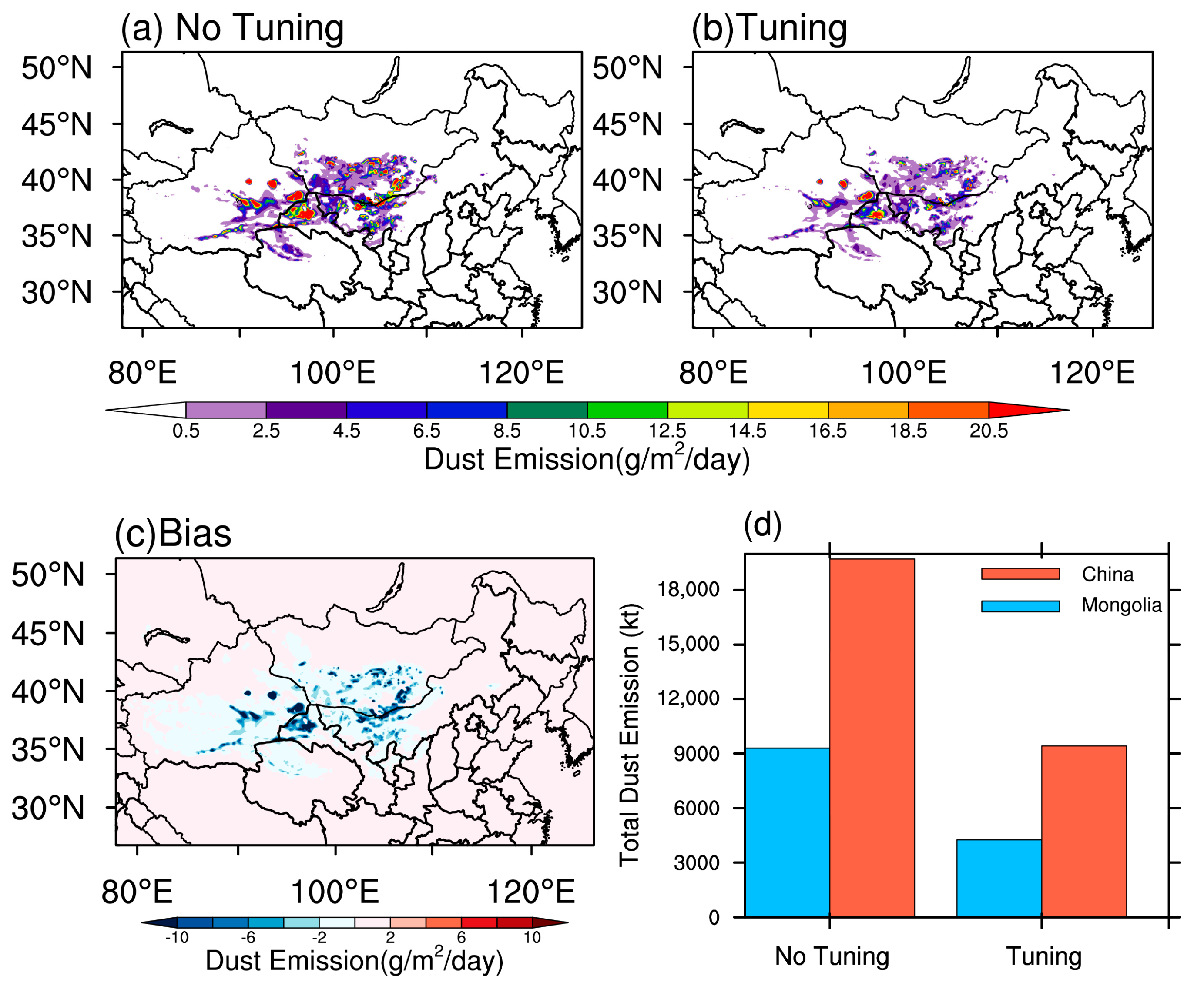
| Option Name | Scheme | Namelist Variable | References |
|---|---|---|---|
| Microphysics | Thompson | mp_physics | [43] |
| Long-wave radiation | rrtmg | ra_lw_physics | [44] |
| Short-wave radiation | Goddard | ra_sw_physics | [45,46] |
| Boundary layer | MYNN 2 | bl_pbl_physics | [47] |
| Land surface | Noah | sf_surface_physics | [48] |
| Chemistry | RADM2 | chem_opt | [49] |
| Dust emissions | Shao 2001 | dust_schme | [32] |
| Date | bin 1 | bin 2 | bin 3 | bin 4 | bin 5 |
|---|---|---|---|---|---|
| 14 March 2021 | 1245.54 (7.4%) | 2197.35 (13.0%) | 2490.76 (14.7%) | 5180.84 (30.7%) | 5770.91 (34.2%) |
| 15 March 2021 | 603.98 (7.7%) | 1061.72 (13.6%) | 1186.51 (15.2%) | 2397.07 (30.8%) | 2553.22 (32.7%) |
| 16 March 2021 | 366.60 (8.0%) | 643.82 (13.8%) | 716.84 (15.5%) | 1429.60 (30.8%) | 1479.83 (31.9%) |
Publisher’s Note: MDPI stays neutral with regard to jurisdictional claims in published maps and institutional affiliations. |
© 2022 by the authors. Licensee MDPI, Basel, Switzerland. This article is an open access article distributed under the terms and conditions of the Creative Commons Attribution (CC BY) license (https://creativecommons.org/licenses/by/4.0/).
Share and Cite
Tang, W.; Dai, T.; Cheng, Y.; Wang, S.; Liu, Y. A Study of a Severe Spring Dust Event in 2021 over East Asia with WRF-Chem and Multiple Platforms of Observations. Remote Sens. 2022, 14, 3795. https://doi.org/10.3390/rs14153795
Tang W, Dai T, Cheng Y, Wang S, Liu Y. A Study of a Severe Spring Dust Event in 2021 over East Asia with WRF-Chem and Multiple Platforms of Observations. Remote Sensing. 2022; 14(15):3795. https://doi.org/10.3390/rs14153795
Chicago/Turabian StyleTang, Weiqi, Tie Dai, Yueming Cheng, Su Wang, and Yuzhi Liu. 2022. "A Study of a Severe Spring Dust Event in 2021 over East Asia with WRF-Chem and Multiple Platforms of Observations" Remote Sensing 14, no. 15: 3795. https://doi.org/10.3390/rs14153795






